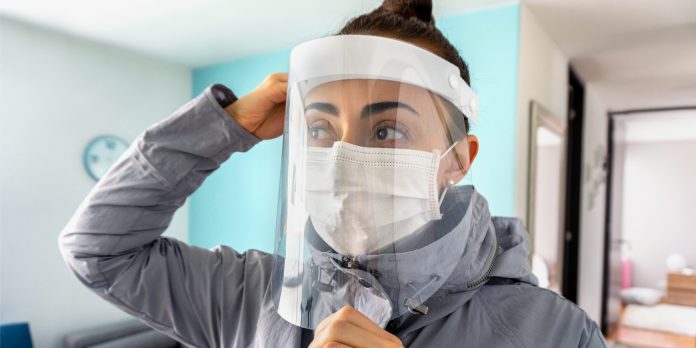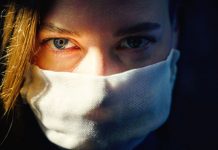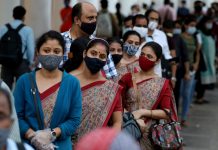For many of us, it’s now standard to don a face mask to go to the grocery store, the pharmacy, or on public transportation. But some people are wearing another type of face covering—a clear plastic shield that covers their entire face known as a face shield.
In April, to help slow the spread of the coronavirus, the Centers for Disease Control and Prevention (CDC) advised everyone to wear a face mask in any public place where other social distancing measures are difficult to maintain. The CDC hasn’t advised the public to wear face shields, which qualify as personal protective equipment (PPE) and are often worn by doctors and health care workers in hospitals.
In a JAMA opinion article published on April 29, Iowa City doctors and public health experts suggested that the face shield was a better option than the face mask for various reasons. Face shields are easier to disinfect than cloth masks, and it’s easier to breathe while wearing one, the researchers wrote. Face shields prevent the wearer from touching much if not all of their face, while a cloth mask only covers the nose, cheeks, and mouth. There’s also no need to remove a shield when you’re talking to someone, which people tend to do with a mask.
“The use of a face shield is also a reminder to maintain social distancing, but allows visibility of facial expressions and lip movements for speech perception,” the researchers wrote. They suggest that face shields could help reduce the number of COVID-19 infections when wearers also practice social distancing and good hand hygiene, and when greater access to testing is available for the virus.
However, not all experts agree that face shields are better than face masks. Infectious disease specialist Bruce Polsky, MD, chairman of medicine at NYU Winthrop Hospital, say that as PPE for health care workers, a face shield is always worn in addition to a face mask, and is not a substitute for one. “They’re particularly important in situations for health care workers where there’s a risk of aerosol spread of the disease and social distancing is not possible,” he tells Health.
“The point of a face shield is to provide an extra layer of protection and to protect the eyes when in close contact with someone that has—or is suspected to have—COVID-19,” says Dr. Polsky. “When talking to someone very close, or sneezing, COVID-19 can be transmitted through the eyes.”
In a health care setting, a face shield provides the added element of “shielding” the mask from potential contamination, thus minimizing the requirement to discard a contaminated mask after a patient encounter,” Charles Bailey, MD, medical director for infection prevention at St. Joseph Hospital and Mission Hospital in Orange County, California, tells Health. “This helps to preserve PPE in resource-limited situations; the face shield can be cleaned after such an event and re-used.”
So clearly, face shields are an important part of PPE for health care workers. But the general public is not typically exposed to that type of high-risk close contact, so doesn’t need the additional protection. Instead of considering a face shield, we should all be wearing a face mask, says Dr. Polsky. “The theory is that if everyone is wearing a face mask, then everyone’s protected,” he explains.
Face shields do have a lot of advantages over masks—like the Iowa researchers note, they’re easier to clean (you can wipe it down with a household disinfectant), reusable, and tend to be more durable and long-lasting. But Dr. Bailey says face shields are more challenging to wear for a variety of reasons, such as vision distortion and the potential to become fogged, and so should only be used when it’s necessary to add eye protection and to shield masks from potential contamination.
Most importantly, face shields do not provide as complete a barrier to block respiratory secretion aerosols from the wearer compared with a mask. A mask creates a complete or near-complete barrier on the sides of the wearer’s face, while a shield is open on the sides, which allows some small particles and aerosols to enter.
So if you’re choosing between one or the other for daily regular use, go for the mask. “A face shield shouldn’t be the preferred form of PPE for people in public places,” says Dr. Bailey. “And wearing both a mask and a shield would be overkill in an attempt to reduce the risk of spread of the coronavirus among asymptomatic individuals in a community setting.”
How you choose to protect yourself and others when you’re out and about is entirely up to you. At this point, it’s probably a better idea to leave face shields for the frontline workers who are risking their lives by coming into close contact with people infected with the coronavirus. Of course, official guidelines are always subject to change—it wasn’t that long ago that the CDC said face masks weren’t necessary.




























